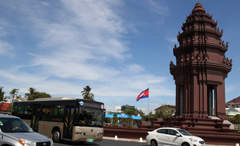Premier’s first foreign trip in 2018 sends signal of good neighborliness
2018-01-12
Xinhua
PHNOM PENH — The first overseas trip in 2018 by a Chinese leader has sent a signal of China’s attaching importance to its neighborhood diplomacy, experts said.
Premier Li Keqiang on Jan 11 concluded a 24-hour trip to Cambodia where he attended the second Lancang-Mekong Cooperation (LMC) leaders’ meeting and paid an official visit to the kingdom.
“It is the first overseas trip in the new year by a Chinese leader and has its significance,” Hu Zhengyue, vice president of China Public Diplomacy Association and former Chinese assistant minister of foreign affairs, told Xinhua.
Hu said the significance can be interpreted from four perspectives —China’s relations with Cambodia, countries on Indo-China Peninsula, China-ASEAN (the Association of Southeast Asian Nations) cooperation, and China’s neighborhood diplomacy.
IMPORTANT CHINA-CAMBODIA TIES
“Bilateral relationship has developed well in general in the past six decades and the visit will inject new impetus into its long-term development,” said Hu Zhengyue.
China hopes to take the opportunity of the 60th anniversary of the establishment of the bilateral diplomatic ties this year to cement high-level contacts, substantial cooperation in various areas and cultural exchanges, Premier Li said during his meeting with Cambodian Prime Minister Samdech Techo Hun Sen.
The Premier vowed to offer assistance for Cambodia’s economic development as well as improvement of people’s livelihood and to jointly build a community of shared future that is of strategic significance.
The two countries also signed 19 bilateral cooperative documents regarding the areas of politics, economy, trade, public health, forestry, agriculture and culture.
“On occasion of the 60th anniversary of the establishment of China-Cambodia ties, it is expected that the China-Cambodia comprehensive strategic cooperative partnership will continue to move forward to bring tangible benefits to the two countries and contribute to peace and development in the region and world,” former Chinese Ambassador to Cambodia Hu Qianwen said.
INNOVATIVE LMC MECHANISM
Drinking from the same Lancang-Mekong river, the six riparian countries share common interest in development and people’s livelihood.
The Lancang River originates on the Qinghai-Tibet Plateau in Southwest China. It is called the Mekong River as it flows through Myanmar, Laos, Thailand, Cambodia and Vietnam before emptying into the sea.
Initiated by China in 2014, the LMC is a sub-regional cooperation mechanism connecting six developing countries along the river. It focuses on five priority areas of cooperation: connectivity, production capacity, cross-border economic cooperation, water resources management, as well as agriculture and poverty reduction.
“The Lancang-Mekong cooperation is a very important platform and its sustainable development will ensure stability and prosperity on Indo-China Peninsula, which has strategic significance for regional countries,” Hu Zhengyue said.
With progress and results delivered daily, a remarkable LMC speed featuring efficiency and pragmatism had been created, said Wang Yuzhu, director and research fellow of the Center for APEC and East Asian Cooperation from Chinese Academy of Social Sciences, adding that the LMC model will become a new platform for regional integration of developing countries.
STRONGER CHINA-ASEAN COOPERATION
On China-ASEAN cooperation, the sound development of the LMC is conducive to ASEAN because an important but thorny issue in the bloc’s integration process is to narrow the development gap between its members, Hu said.
“China’s participation in the LMC will help ASEAN’s efforts in this aspect (narrowing the disparity between its member countries) and help deepen China-ASEAN cooperation,” he said.
Most of the LMC’s 45 Early Harvest Projects have been completed and recorded substantive progress, which also contributes to the cooperation between China and ASEAN.
“The visit has demonstrated the importance China attaches to its relations with neighboring countries, especially with ASEAN,” said Guo Yanjun, director of the Institute of Asian Studies of China Foreign Affairs University. “A prosperous ASEAN that enjoys development and integration is also conducive to promoting our major-country diplomacy.”
GOOD NEIGHBORS AND WIN-WIN COOPERATION
According to Hu Zhengyue, China’s neighborhood diplomacy that features amity, sincerity, mutual benefit and inclusiveness is the country’s “top priority.”
China benefits from regional stability and its neighbors also benefit from China’s development.
For the long-term win-win cooperation in the region, a LMC culture featuring equality, sincerity, mutual assistance and kinship should be a common pursuit, said Liu Chang, a research fellow from China Institute of International Studies.
People-to-people and cultural exchanges will be the “soul” to cultivate the LMC culture, thus stimulating a strong vitality and benefiting the six peoples in the future, said the expert.


